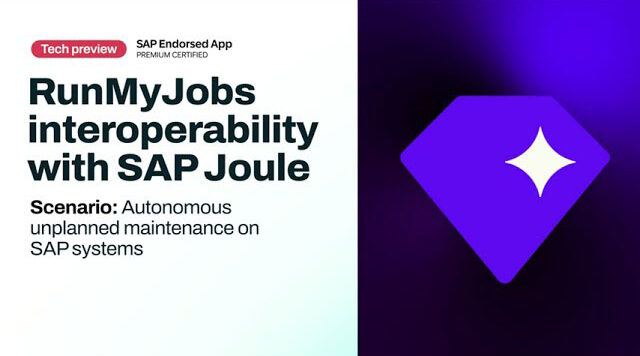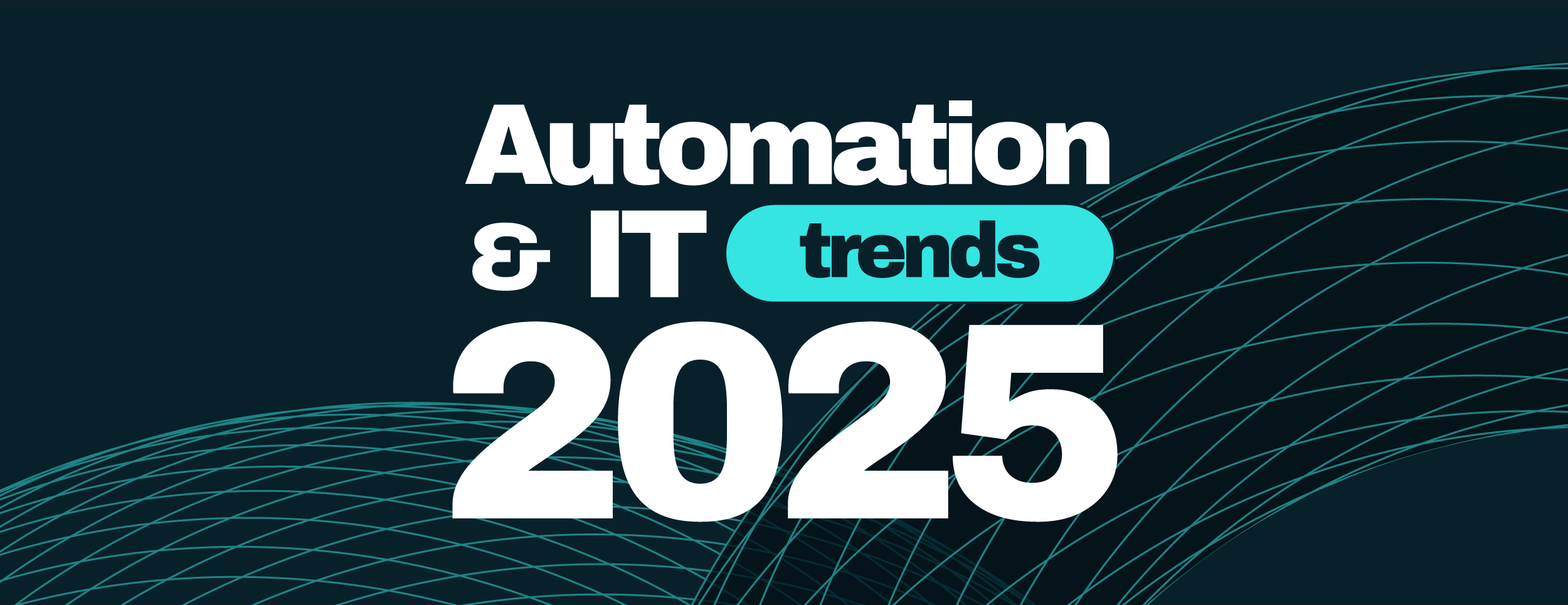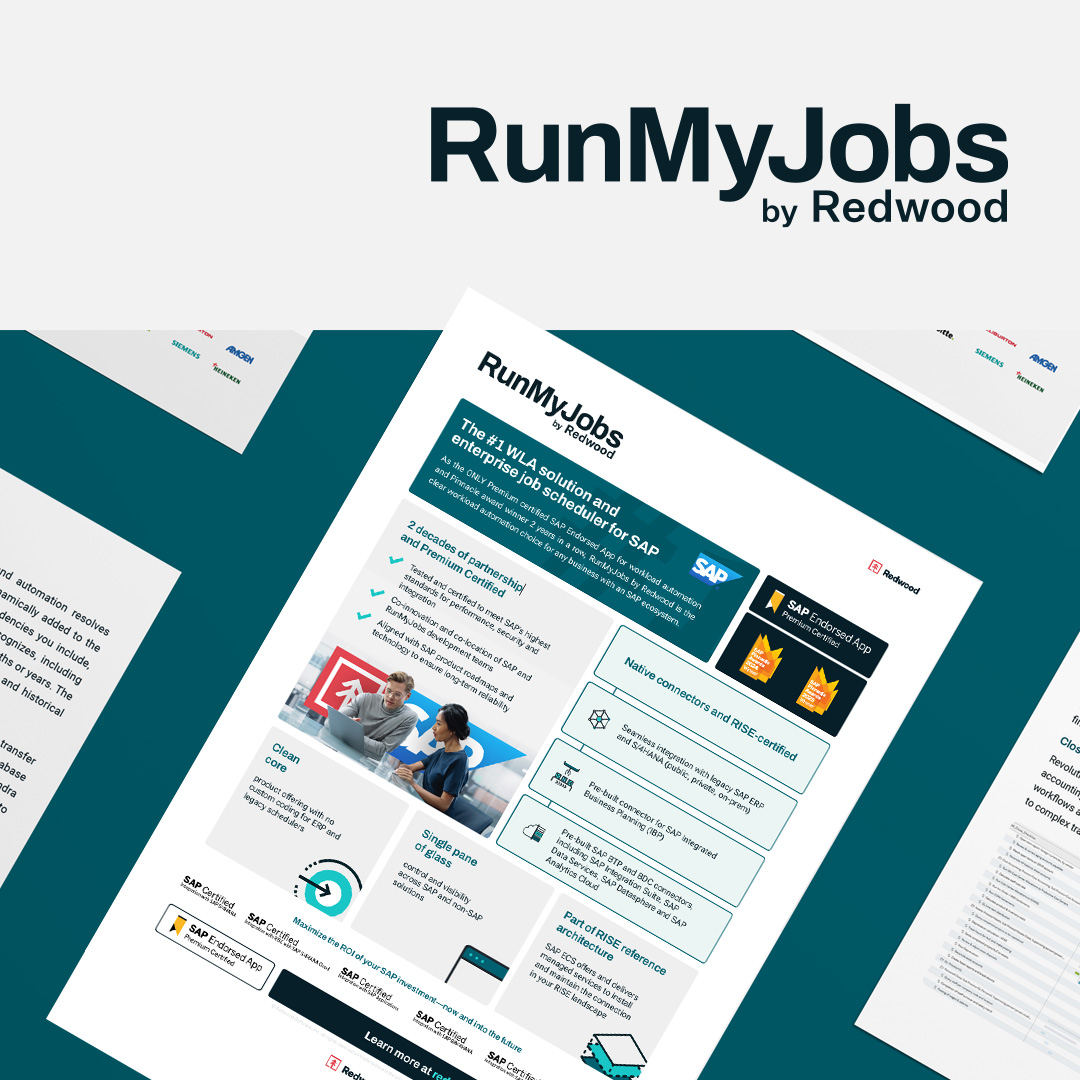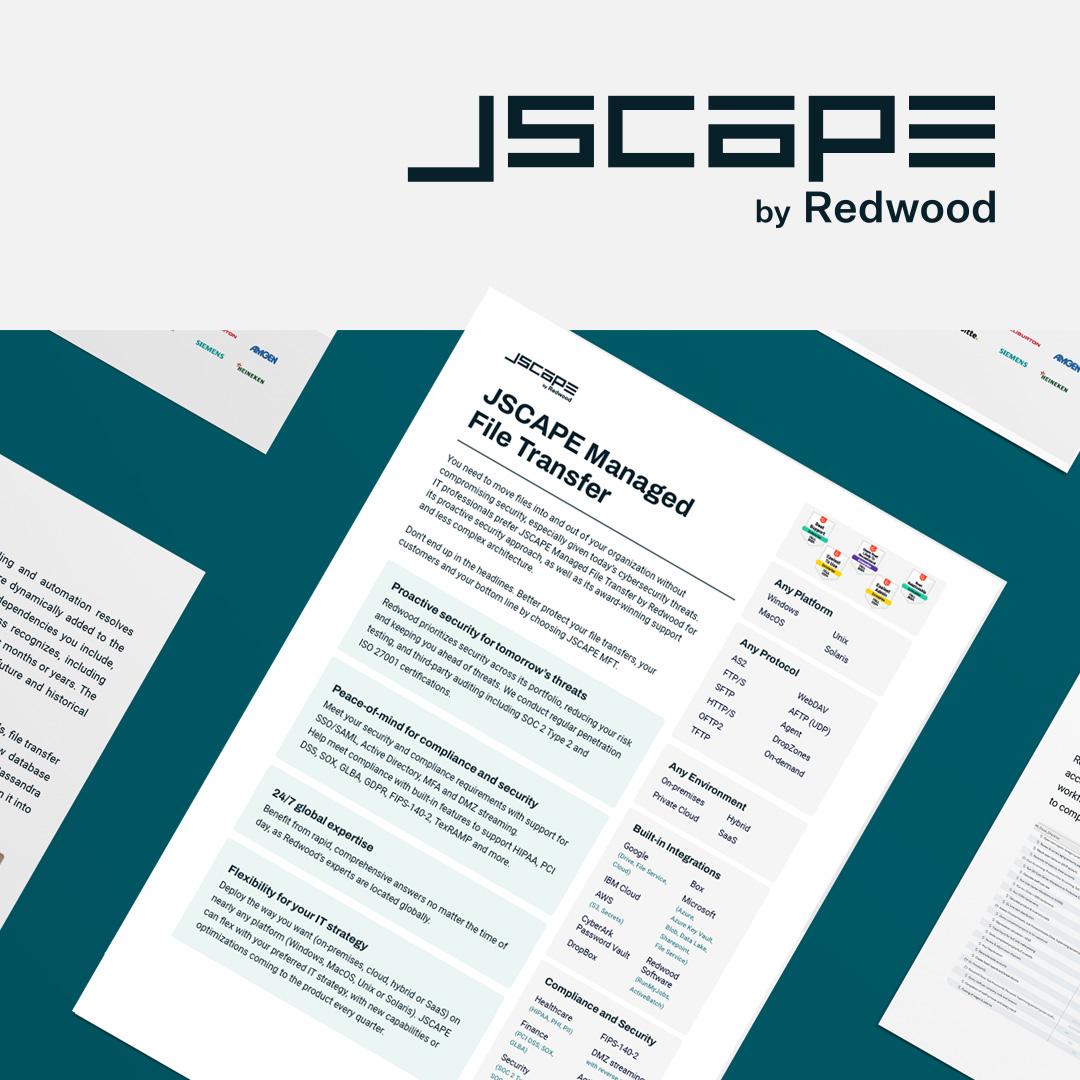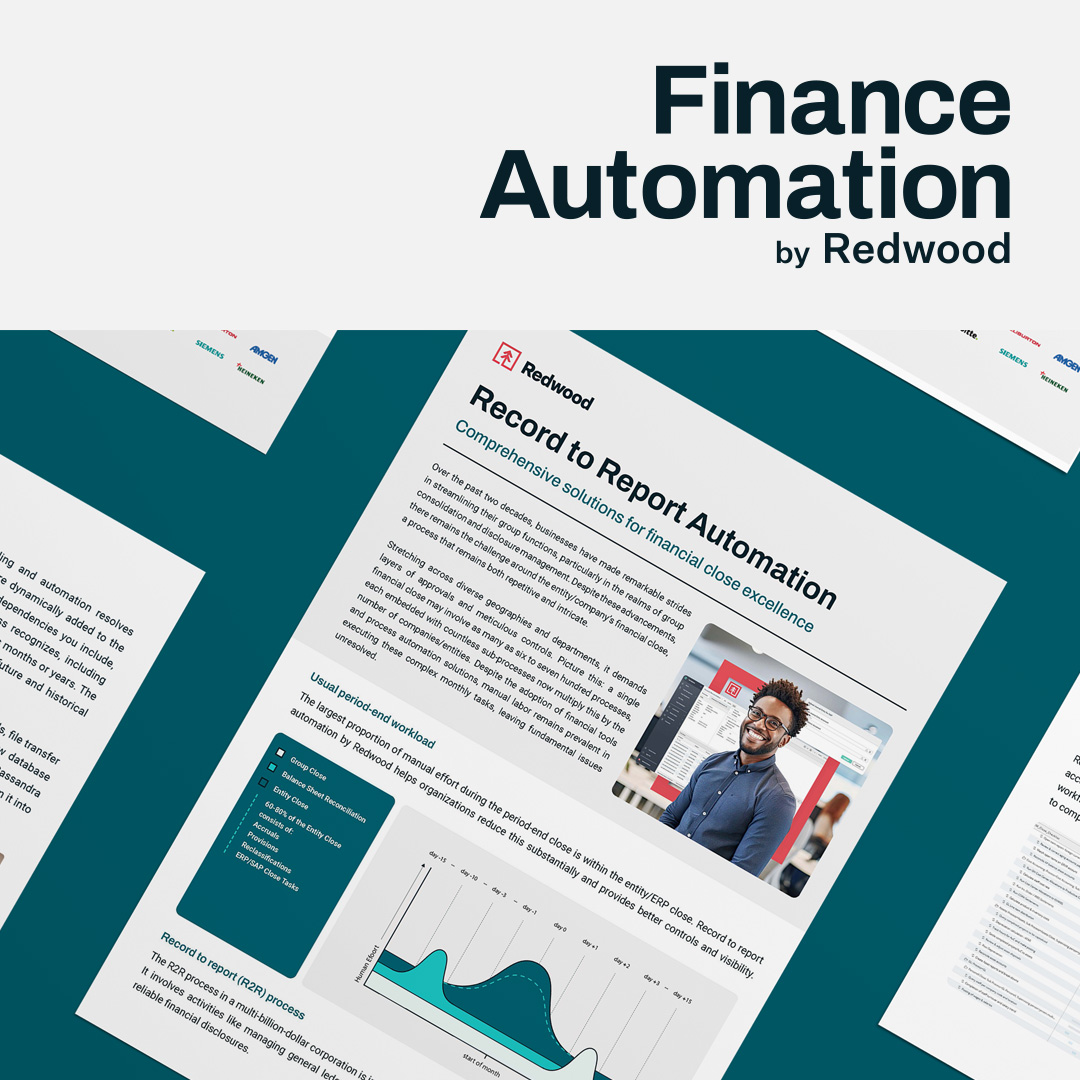Proven orchestration for the era of autonomous enterprise operations
It’s time to move beyond automation to goal-oriented outcomes. Redwood Software harnesses the power of AI to provide the foundational automation and governance layer you need to maximize agility, efficiency and ROI.

More than features: Future-proof your AI investment
Securely weave next-generation AI into your mission-critical business processes. The world’s leading enterprises trust Redwood to orchestrate across legacy infrastructure, cloud and AI.
-
Drive strategic outcomes with AI
Integrate AI into every stage of the automation lifecycle, from workflow design and troubleshooting to support and large-scale, agentic AI-powered operations.
-
Govern automation at scale
Avoid chaotic, siloed AI with a control plane ready for agentic innovation. Standardize how AI agents plan, act and learn with one orchestration framework.
-
Integrate AI with confidence
Avoid lock-in and leverage your existing investments. Redwood works with your providers and platforms, from SAP to Salesforce, Microsoft and more, so you can streamline and reach goals faster.
Leading through every era of automation
Redwood has guided customers through every major transformation in enterprise IT, helping to modernize, automate and now infuse AI safely and efficiently into their most critical processes. As the market enters the era of autonomous enterprise orchestration, Redwood continues to enable innovation that’s practical, governed and built to last.
The same reliability that powered past transformations now underpins the move toward AI-driven operations

The challenge: Bridging automation and intelligence
You’ve built years of reliable, rule-based automation. Now, you’re tasked with connecting it with intelligent systems that can learn, adapt and decide in real time. The challenge isn’t adopting artificial intelligence; it’s linking reasoning to action without losing control.
On the way, you might face some barriers:
- Complexity: Legacy tools can’t adapt to dynamic, goal-driven AI models.
- Fragmentation: Disconnected platforms create risk and limit scalability.
- Governance: AI initiatives must be compliant, auditable and aligned with your business objectives.
To stay competitive, you need a foundation that connects your existing, deterministic automation with emerging AI capabilities.
The shift: Enabling autonomous evolution
Redwood can provide the bridge to progress from rule-based workflows to outcome-driven automation. Give your IT team the interoperable platform they need to manage innovation safely while your business teams harness AI to boost daily productivity.
-
Unify automation and AI systems
Connect your existing workflows with AI tools, models and agents through open APIs and event-driven triggers.
-
Coordinate agent-based operations
Manage multiple AI agents working together toward shared business goals while maintaining visibility, security and control.
-
Empower user-facing intelligence
Enable employees to interact with AI assistants that translate human intent into structured goals with a platform that governs the new agentic ecosystem safely.
-
Orchestrate dynamic execution
Use a central orchestration layer to interpret goals, generate multi-step plans and dispatch them to specialized agents performing tasks across your enterprise systems.
-
Build for interoperability
Redwood supports emerging open standards like Agent2Agent (A2A) and Model Context Protocols (MCP), which means your AI strategy remains agile, scalable and future-ready.

Lead the agentic shift
Agentic AI changes everything about how work gets done. With orchestration, governance and autonomy come together to create resilient, self-healing systems under human oversight.
Agentic AI in your world
See how you might apply an AI-ready automation platform like RunMyJobs by Redwood to achieve measurable results.

Dynamic supply chain optimization
Challenge: A shipping delay forces your logistics planner into slow, manual troubleshooting, querying multiple systems to find one viable fix.
Solution: An AI-powered system autonomously investigates the impact, finds all viable alternatives and presents options to your planner in minutes.
Example: Automated back-office investigation
- An agent monitoring delivery data detects the delay and alerts the orchestration layer
- In seconds, other agents are dispatched to gather context:
- One queries your ERP for affected orders and the impact on production schedules
- Another checks warehouse inventory and suppliers to identify replacements
- A third analyzes logistics systems for shipping and cost options
- The orchestrator compiles findings into a ranked list of outcomes, ready for human approval
- Your logistics planner makes the final call
What would have been a multi-day crisis becomes a data-driven decision that takes minutes.
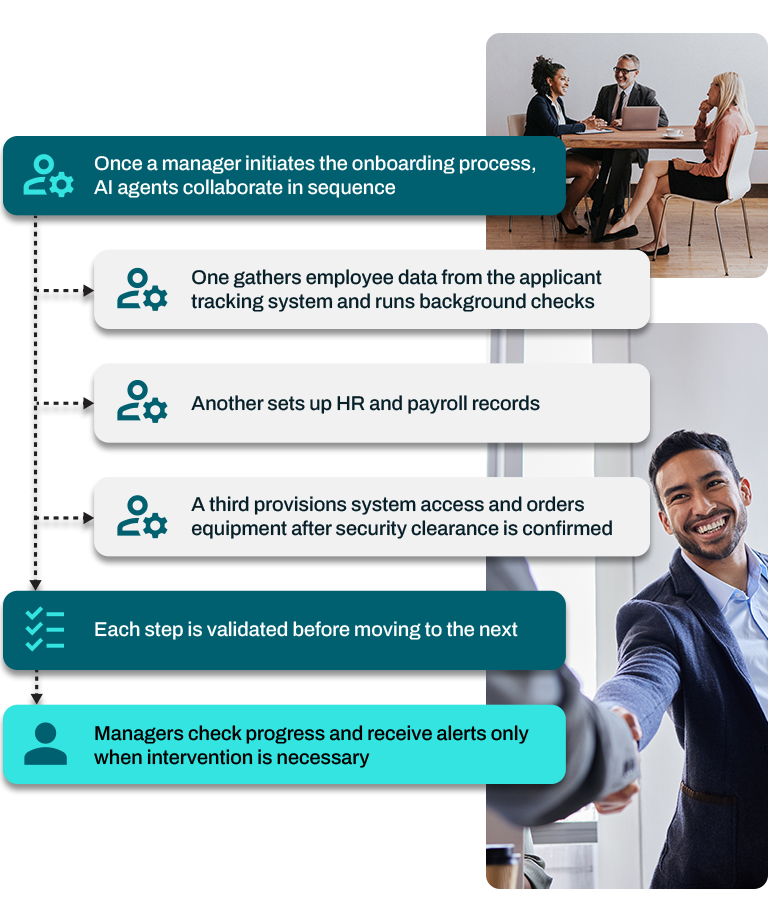
Adaptive HR onboarding
Challenge: Onboarding triggers a cascade of slow, error-prone manual data entry across disconnected HR, IT and Finance systems.
Solution: You state a goal (e.g., “Onboard Jane Doe”), and an AI system autonomously plans and orchestrates every backend task.
Example: Automated back-office execution
- Once a manager initiates the onboarding process, AI agents collaborate in sequence
- One gathers employee data from the applicant tracking system and runs background checks
- Another sets up HR and payroll records
- A third provisions system access and orders equipment after security clearance is confirmed
- Each step is validated before moving to the next
- Managers check progress and receive alerts only when intervention is necessary
This model is highly resilient. If a single step fails, the system intelligently retries or escalates that one task to your team, without stopping the entire workflow.
Evolving SAP automation for the AI era
SAP’s expanding AI ecosystem is redefining supply chain management, analytics and other core business processes. RunMyJobs is a bridge to intelligent decision-making, connecting AI insights and automated workflows.

Transform RunMyJobs actions into agentic Joule skills
Unlock a new level of business agility by connecting RunMyJobs directly to SAP Joule. Empower your business users to securely access and run complex IT automations using simple, natural language commands.
Automation is accessible yet governed. Your IT teams maintain complete control, selectively publishing specific, pre-approved operations, controlled through the SAP Accelerator Hub and SAP BTP Cockpit with enterprise-grade permissions.
For your users, the result is simple. Complex, multi-step processes become a single conversational command in SAP Joule. They can gather data, manage workflows and accelerate decision-making without deep technical knowledge.
Autonomous SAP system maintenance
Challenge: An unplanned SAP restart often sparks a high-priority call between Basis, automation and integration teams, each managing their own systems and checklists, which leads to errors and downtime.
Solution: RunMyJobs and SAP Joule streamline this complex event into a single workflow that can be easily initiated and safely executed.
Example: Automated system coordination
- A Basis lead initiates the restart in SAP Joule
- Joule interprets the request and passes it to RunMyJobs
- RunMyJobs pauses active job queues and undeploys SAP BTP iFlows
- The orchestration layer confirms when all dependencies are safely paused
- SAP Joule provides a status update and requests final approval
- The system restores operations in the correct order and logs all actions
A complex, high-stress event is transformed into a simple confirmation, minimizing downtime and keeping your team in full control.
AI-ready orchestration isn’t limited to SAP environments — it’s modernizing how enterprises automate everywhere
Introducing Redwood RangerAI
Redwood RangerAI is an integrated intelligence layer purpose-built for enterprise use cases. Designed to work across every stage of the automation lifecycle, it boosts skillsets, improves accuracy and drives business impact without adding complexity.
-
Turn novices into experts
Make onboarding and upskilling effortless with the in-platform Product Assistant, delivering context-aware guidance to answer your “how-to” questions, resolve issues and discover best practices without leaving the RunMyJobs interface.
-
Build better automations, faster
Turn ideas into execution with the Automation Co-pilot, which can help you build, document and scale your workflows in a fraction of the time while reducing manual errors and maintaining compliance.
-
Get product answers instantly
Ask deep technical questions and receive accurate, immediate answers with the Learning Assistant: an enhancement to public documentation across all Redwood solutions.
Preview Redwood RangerAI
Watch how it transforms everyday automation in RunMyJobs.
Not just another LLM
Redwood RangerAI isn’t a generic chatbot or plug-in. It’s a set of powerful AI capabilities woven into the fabric of the platform you already trust.
-
Integrated, not bolted on
Embedded throughout the automation lifecycle, enhancing design, execution and optimization without adding new infrastructure
-
Grounded in reality, not AI hype
Built on decades of enterprise automation expertise — made to solve practical problems and deliver a clear return on investment
-
Secure by design
Trained to interact with your data in a highly controlled and secure manner, within strict governance and data privacy frameworks, to guarantee outcomes
-
Transparent and trustworthy
Offering full observability, detailed reporting and complete visibility into how AI is optimizing your mission-critical workflows
Insights shaping the future of automation
Stay ahead of the curve — explore topics in AI, automation and orchestration with Redwood solutions.
How AI turns automation into outcomes
Your organization has most likely been developing an AI strategy to streamline complex tasks and improve adaptability.
In this session, Redwood’s Chief Product Officer, Charles Crouchman, addresses real-world applications of AI in automation platforms, how agentic AI works and how to enable your teams to adopt new AI technology.
Agentic AI and the new logic of automation
Dive deeper into how agentic AI is bringing autonomy, adaptability and intelligence to everyday workflows.
Bring your autonomous vision to life with Redwood solutions
Prepare your automation landscape for an intelligently orchestrated future.
The Redwood RangerAI portfolio
Redwood is expanding the automation lifecycle with AI-powered enhancements designed to maximize productivity and reduce risk. Learn what’s possible today, and what AI-powered features are in the works
-
Learning Assistant
Ask complex technical questions across all Redwood products, anytime.
-
Product Assistant
Get in-platform, context-aware guidance for faster onboarding and troubleshooting.
-
Automation Co-pilot
Dramatically speed up design and optimize automations with AI-assisted development.
-
Support Assistant
Resolve issues instantly with AI trained on decades of automation expertise.
-
SAP Joule interoperability
Empower business users with natural language access to governed automations.
-
Agentic orchestration
Preview the next stage of automation maturity, in which autonomous agents drive end-to-end operations.

Unify generative and process intelligence
Save time, reduce manual effort and boost scalability with the combined power of ChatGPT and RunMyJobs.
- Trigger and interact with ChatGPT in RunMyJobs to turn unstructured data into structured data and create data flows across pre-defined processes
- Perform a ChatGPT request that returns a string containing the ChatGPT response and a table containing a log of the conversation
- Access a real-time audit trail of triggers, results and processes
Stay connected
AI and automation are evolving fast. Get the latest insights, demos and updates as Redwood continues shaping the future of intelligent orchestration.
Get AI-driven automation updates
Agentic AI FAQs
What is traditional AI?
Traditional artificial intelligence refers to rule-based systems and machine learning models designed to automate repetitive tasks, process structured datasets and support decision-making through defined algorithms. These AI applications often require human oversight and don’t act autonomously.
What is generative AI?
Generative AI (genAI) uses large language models (LLMs) and neural networks to create new content, such as text, code or images, based on learned data patterns. In business use cases, genAI enhances customer support, content generation and software development by automating high-volume outputs that once required human input.
What is natural language processing (NLP)?
Natural language processing (NLP) is a branch of artificial intelligence that enables computers to understand, interpret and generate human language. It powers chatbots, voice assistants and AI models that read and summarize text or respond conversationally.
In automation, NLP helps transform unstructured data into structured outputs, making it easier for AI tools and orchestration platforms to trigger actions, analyze vast amounts of data and support real-time decision-making. NLP also serves as a foundation for generative AI and agentic AI, allowing autonomous systems to communicate and collaborate with humans more naturally.
What is the difference between generative AI and agentic AI?
Generative AI (genAI) uses large language models (LLMs) and other machine learning techniques to produce outputs when prompted. Agentic AI uses AI models plus planning, decision-making and tools to achieve outcomes with minimal human intervention. In practice, genAI is typically reactive (prompt in, content out), while agentic AI systems are proactive: breaking a complex goal into subtasks, calling external tools/APIs, incorporating real-time data and adjusting via feedback loops (often with guardrails and human oversight). GenAI streamlines specific tasks, and agentic AI aims to orchestrate complex workflows across end-to-end business processes.
What is agentic AI automation?
AI agentic automation describes the use of autonomous AI agents to coordinate and optimize complex workflows across ecosystems. It blends the scalability of automation with the adaptability of intelligent agents, enabling systems to make decisions, monitor outcomes and improve processes continuously.

